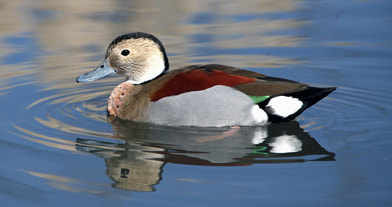Ringed Teal (Callonetta leucophrys)

Common Name: Ringed Teal
Scientific Name: Callonetta leucophrys
Physical Description: Ringed Teals are wood ducks that are 14 to 15 inches in length, with a 28-inch wingspan. They only weigh about 12 ounces.
Ringed Teals have slender gray-blue bills that have many tiny, plate-like ridges along the edges called lamellae. The lamellae are coarse and allow them to cut vegetation like teeth. They have brown eyes. Adults have beautiful iridescent green plumage. They can be identified especially by the white patch in front of a bright green patch of plumage (called the speculum).
The male Ringed Teal, called a drake, has a speckled, pinkish breast and a light tan head that is bordered by a striking black line of plumage. The black line extends down to the base of the neck and then partially around it, forming an incomplete ring. Males also have dark, chestnut backs and gray flanks. Female Ringed Teals, called hens, are less vibrant. They have an olive brown back, a barred chest and belly, and white blotches on the head. They have a dark tail and pale rump.
Ringed Teals have light pink legs and toes with sharp strong claws that allow them to perch high in trees. They are considered dabbling ducks. Dabbling means they swim and dip their bills, heads and necks into the water to filter out and forage for food but they do not dive or submerge their bodies underwater.
Ringed Teal females’ vocalization is a harsh “quack”, while the males’ is a soft, long whistle.
Habitat: They live near secluded pools, small streams, swampy tropical forests, ponds, marshy clearings in low woodlands, and often in forested habitats.
Range: Ringed teals live in forested wetlands in South America from southern Bolivia, to Paraguay, to southwestern Brazil, to northeastern Argentina and Uruguay.
Diet: They are omnivores. They eat aquatic plants, insects, seeds, small fish, and snails.
Lifespan: They live 13 years on average.
Social Structure: Ringed Teals form strong pair bonds, which may or may not be lifelong. They nest in holes or other tree cavities that they have lined with down. They lay an average clutch of 6 to 11 eggs. Both parents help incubate the eggs.
The ducklings are precocial, meaning they are well developed when they hatch. Once the eggs have hatched the parents leave the nest. The ducklings will follow by leaping from the nest. They waterproof their feathers by rubbing against their mother’s abdominal plumage. They follow their mother to water and eat on their own. They can fly approximately 53 days after hatching.
Status: Least Concern1
Other: This duck species is a member of the wood duck group and is one of the smallest ducks in the world. Like all wood ducks, the Ringed Teal has a distinctive gait. When walking on land it appears almost to limp. They are agile, strong fliers and are also known as “perching ducks”.
1 https://www.iucnredlist.org/species/22680101/194736119
Scientific Name: Callonetta leucophrys
Physical Description: Ringed Teals are wood ducks that are 14 to 15 inches in length, with a 28-inch wingspan. They only weigh about 12 ounces.
Ringed Teals have slender gray-blue bills that have many tiny, plate-like ridges along the edges called lamellae. The lamellae are coarse and allow them to cut vegetation like teeth. They have brown eyes. Adults have beautiful iridescent green plumage. They can be identified especially by the white patch in front of a bright green patch of plumage (called the speculum).
The male Ringed Teal, called a drake, has a speckled, pinkish breast and a light tan head that is bordered by a striking black line of plumage. The black line extends down to the base of the neck and then partially around it, forming an incomplete ring. Males also have dark, chestnut backs and gray flanks. Female Ringed Teals, called hens, are less vibrant. They have an olive brown back, a barred chest and belly, and white blotches on the head. They have a dark tail and pale rump.
Ringed Teals have light pink legs and toes with sharp strong claws that allow them to perch high in trees. They are considered dabbling ducks. Dabbling means they swim and dip their bills, heads and necks into the water to filter out and forage for food but they do not dive or submerge their bodies underwater.
Ringed Teal females’ vocalization is a harsh “quack”, while the males’ is a soft, long whistle.
Habitat: They live near secluded pools, small streams, swampy tropical forests, ponds, marshy clearings in low woodlands, and often in forested habitats.
Range: Ringed teals live in forested wetlands in South America from southern Bolivia, to Paraguay, to southwestern Brazil, to northeastern Argentina and Uruguay.
Diet: They are omnivores. They eat aquatic plants, insects, seeds, small fish, and snails.
Lifespan: They live 13 years on average.
Social Structure: Ringed Teals form strong pair bonds, which may or may not be lifelong. They nest in holes or other tree cavities that they have lined with down. They lay an average clutch of 6 to 11 eggs. Both parents help incubate the eggs.
The ducklings are precocial, meaning they are well developed when they hatch. Once the eggs have hatched the parents leave the nest. The ducklings will follow by leaping from the nest. They waterproof their feathers by rubbing against their mother’s abdominal plumage. They follow their mother to water and eat on their own. They can fly approximately 53 days after hatching.
Status: Least Concern1
Other: This duck species is a member of the wood duck group and is one of the smallest ducks in the world. Like all wood ducks, the Ringed Teal has a distinctive gait. When walking on land it appears almost to limp. They are agile, strong fliers and are also known as “perching ducks”.
1 https://www.iucnredlist.org/species/22680101/194736119






